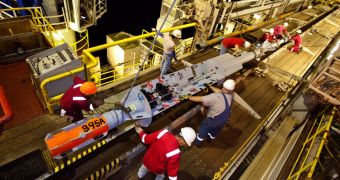The only ecosystem left to explore on our world is also one that could finally allow us to better understand our planet. Inside the igneous ocean crust that lies beneath the sediments of the ocean floor, species of microorganisms live in conditions that have not changed for eons.
Needless to say, analyzing these lifeforms could lead paleobiologists, paleoclimatologists and geologists to a deeper understanding of how Earth evolved over millions of years. But it's precisely this environment that is the least explored of all known to house life.
The igneous crust is made up of hard volcanic lava, and somehow microorganisms found a way to live deep inside it. They survive even though the pressure at those locations is tremendous. What is even more remarkable is that they are believed to make up about a third of Earth's total biomass.
Scientists are even talking about a habitable portion of the rocky ocean crust, which they now say is about 10 times larger than previously established. In order to set the record straight, experts embarked on the Integrated Ocean Drilling Program (IODP) Mid-Atlantic Ridge Microbiology Expedition.
Using the research vessel JOIDES Resolution, an international collaboration of investigators traveled to a remote area in the Atlantic Ocean, called North Pond. Once they deployed their equipment, they were able to install a host of observatories underneath the ocean's sediment layer.
These Circulation Obviation Retrofit Kits (CORKs) may be just the right thing when it comes to establishing the exact degree to which microbes and other similar lifeforms change the oceanic crust, and potentially even the oceans themselves.
“The innovative and novel experiments and observations from this expedition promise to greatly advance our understanding of the nature and extent of microbial life in the most widespread of environments – the Earth's ocean crust,” Jamie Allan explains.
The expert holds an appointment as a program director for IODP. He is based at the National Science Foundation (NSF), the organization that provides the bulk of funds the IODP needs to operate. The remaining portion comes from Ministry of Education, Culture, Sports, Science and Technology in Japan.
The NSF lists three main questions on its website that the IODP needs to answer. The data needed for that will be provided by multiple CORKs. These devices are scheduled to remain in place for as much as 10 years. The three questions are:
What is the nature of subseafloor microbial communities, and what is their role in the alteration of relatively young ocean crust? Are these communities unique, particularly in comparison with seafloor and sedimentary communities? Where do microbes in the igneous ocean crust come from (sediment, rock, seawater or another source)?

 14 DAY TRIAL //
14 DAY TRIAL //